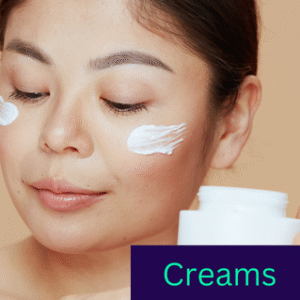
Creams are semi-solid emulsions of oil and water designed for application on the skin. They are one of the most common types of cosmetic and pharmaceutical formulations, valued for their ability to moisturize, protect, and deliver active ingredients to the skin.
Basic Structure of Creams:
-
Oil Phase: Oils, butters, waxes, emulsifiers
-
Water Phase: Water, humectants (like glycerin), water-soluble actives
-
Emulsifier: Keeps the oil and water blended
-
Actives: Targeted ingredients for skincare benefits (e.g., vitamins, herbal extracts)
-
Preservatives: To prevent microbial growth
Types of Creams:
| Type | Description | Common Uses |
|---|---|---|
| Oil-in-Water (O/W) Cream | More water, lighter texture | Day creams, moisturizing creams |
| Water-in-Oil (W/O) Cream | More oil, richer texture | Night creams, barrier creams |
| Anhydrous Cream | No water, purely oil-based | Healing balms, ointments |
Key Benefits of Creams:
-
Hydration: Replenish moisture in the skin.
-
Protection: Act as a barrier against environmental stressors.
-
Targeted Treatment: Deliver active ingredients (anti-aging, brightening, soothing).
-
Texture: Smoother and richer than lotions, but less greasy than ointments.
Common Active Ingredients:
-
Moisturizers: Hyaluronic Acid, Glycerin, Ceramides
-
Brightening: Vitamin C, Niacinamide, Alpha Arbutin
-
Anti-aging: Retinol, Peptides, Collagen
-
Soothing: Aloe Vera, Centella Asiatica, Calendula
-
Sunscreen agents: Zinc Oxide, Titanium Dioxide, Chemical UV filters
